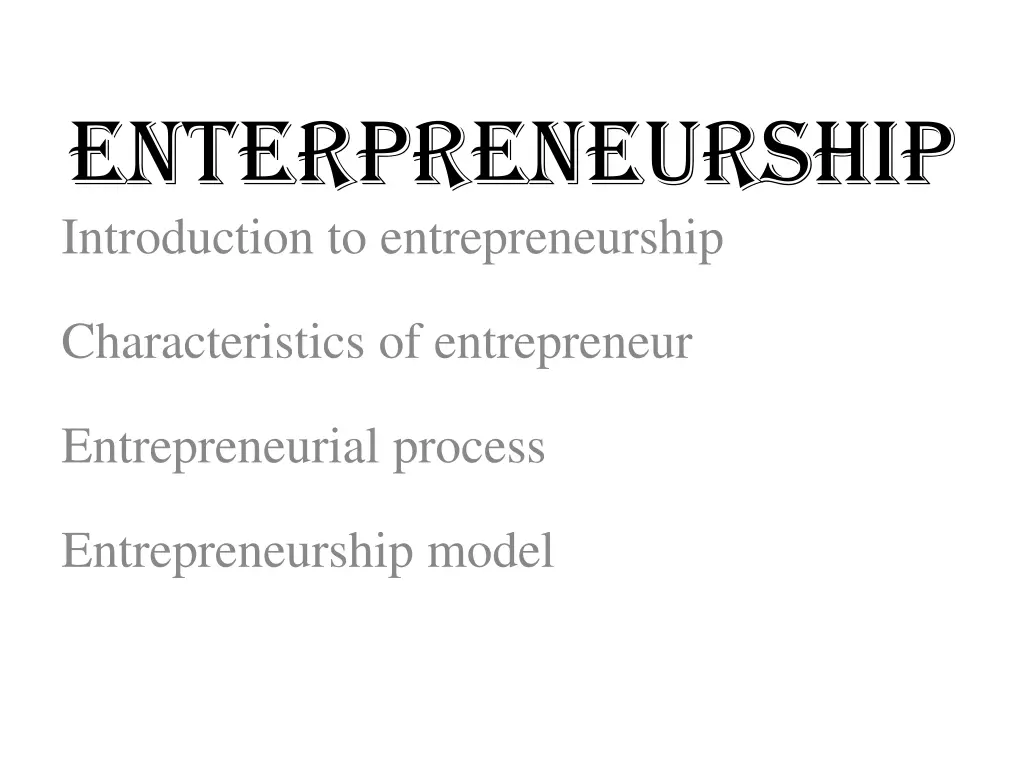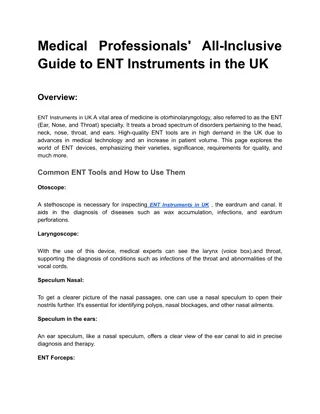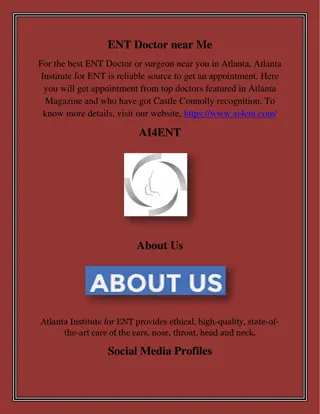
Entrepreneurship: Characteristics, Process, and Benefits
Discover the essence of entrepreneurship with insights into the characteristics of entrepreneurs, the entrepreneurial process, and the benefits associated with venturing into entrepreneurship. Uncover what it takes to be an entrepreneur and the potential drawbacks one might face on this rewarding yet challenging journey.
Uploaded on | 0 Views
Download Presentation

Please find below an Image/Link to download the presentation.
The content on the website is provided AS IS for your information and personal use only. It may not be sold, licensed, or shared on other websites without obtaining consent from the author. If you encounter any issues during the download, it is possible that the publisher has removed the file from their server.
You are allowed to download the files provided on this website for personal or commercial use, subject to the condition that they are used lawfully. All files are the property of their respective owners.
The content on the website is provided AS IS for your information and personal use only. It may not be sold, licensed, or shared on other websites without obtaining consent from the author.
E N D
Presentation Transcript
ENTERPRENEURSHIP Introduction to entrepreneurship Characteristics of entrepreneur Entrepreneurial process Entrepreneurship model
Introduction to entrepreneurship This is the era of the entrepreneur! Through the world, growing numbers of people are realizing their dreams of owning and operating their own business. Entrepreneurship is thriving. The past two decades have seen record numbers of entrepreneurs launching new businesses and each year.
What is Entrepreneurship? The capacity and willingness to develop, organize and manage a business venture along with any of its risks in order to make a profit. The most obvious example of entrepreneurship is the starting of new businesses. In economics, entrepreneurship combined with land, labor, natural resources and capital can produce profit.
What is an entrepreneur? An entrepreneur is someone that creates a new business. This can carry a high risk because it requires money to set up a new business without knowing if it will give a return on investment. An entrepreneur: Sees an opportunity. Makes a plan. Starts the business. Manages the business. Receives the profits.
Characteristics of entrepreneur Desire for responsibility Preference for moderate risk (risk eliminators) Confidence in their ability to succeed Desire for immediate feedback High level of energy Future orientation (serial entrepreneurs) Skill in organization Value of achievement over money High degree of commitment Willingness to accept risk, work hard and take action Flexibility
The Benefits of Entrepreneurship The primary benefits entrepreneurs enjoy include the opportunity to: Create their own destiny Make a difference Reach their full potential Generate impressive profits Contribute to society and be recognized for their efforts Do what they enjoy and have fun at it!
The Potential Drawbacks of Entrepreneurship With these potential rewards, Entrepreneurship also presents risk and uncertainty. Entrepreneurs may experience: Uncertainty of income The entrepreneur is the last one to be paid. Risk of losing their entire investment Long hours and hard work Lower quality of life until the business gets established High levels of stress Complete responsibility Discouragement
Trends of the Entrepreneurship The rapid increase in entrepreneurs has been a result of: Considering entrepreneurs as heroes Entrepreneurial education Demographic and economic factors Shift to a service economy Technological advancements Independent lifestyles Commerce and the Internet Additional international opportunities
Growth of entrepreneurship Entrepreneurs are found in virtually every walk of life including: Young Entrepreneurs Women Entrepreneurs Minority Enterprises Immigrant Entrepreneurs Part-time Entrepreneurs Home-Based Businesses Family Businesses Co-preneurs Corporate Castoffs Corporate Dropouts
Why entrepreneur Fail? 1. Management mistakes 2. Lack of experience 3. Poor financial control 4. Weak marketing efforts 5. Failure to develop a strategic plan 6. Uncontrolled growth 7. Poor location 8. Improper inventory control 9. Incorrect pricing 10. Inability to make the entrepreneurialtransition
How to Avoid the Pitfalls? These entrepreneurs can increase their changes for success if they: Know their business in depth. Develop a solid business plan in writing. Manage financial resources. Understand financial statements. Learn to manage people effectively. Keep in tune with who they are. same studies have indicated that
Introduction to entrepreneurship Characteristics of entrepreneur Entrepreneurial process Entrepreneurship model
Entrepreneurial process The process of starting a new venture is embodied in the entrepreneurial process, which involves more than just problem solving in a typical management position. An entrepreneur must find, evaluate, and develop an opportunity by overcoming the forces that resist the creation of something new.
The Entrepreneurial Process The Entrepreneurial Process Consists of 4 Steps Step 1: Deciding to become an entrepreneur. Step 2: Developing successful business ideas. Step 3: Moving from an idea to an enterprise. Step 4: Managing and growing the enterprise. 1-14
Introduction to entrepreneurship Characteristics of entrepreneur Entrepreneurial process Entrepreneurship model
Entrepreneurship model Entrepreneurship is not something special that a few people are born with. Entrepreneurship is a way of thinking that can be nurtured. So the question is; An entrepreneur is born or made The ACRO model was introduced to focus on the attitudes, skills and behaviors needed to enable young people to meet the needs of business in the 21st century
ACRO Is the abbreviation of; Attitude Creativity Relationship Organization
Attitude. If you want to succeed at anything in life, having the right attitude is vital. This dimension is about understanding yourself, your motivations and how to achieve your goals. Self knowledge, belief and confidence Motivation Aspiration Determination Competitiveness
Creativity. You don t need to be a genius to be creative. It is about the ability to generate fresh ideas, solve problems and spot new opportunities Problem solving Lateral thinking / ideas generation Spotting and creating opportunities Innovation
Relationship. It s all about people, the ability to communicate effectively, expressing your own views and ideas, appreciating others viewpoint and working co- operatively Working with others Managing difficult situations Negotiation, persuasion and influence Presentation Communication
Organization. Making informed decisions and fulfilling your objectives by planning and managing situations, resources and risk Planning Managing resources Decision making Research and understanding the environment Managing risk Vision and goal setting
Conclusion. This model is used as the foundation for all the resources and programme development. Providing the highlight the skills and attitudes needed by young people to succeed, and how these are applied in their everyday lives






















